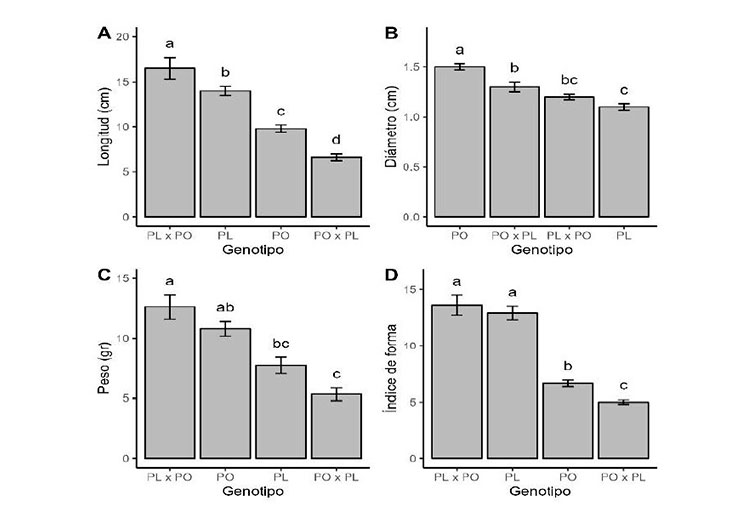Presence of metaxenia in fruits 40 days postpollination in Vanilla planifolia Andrews and V. pompona Schiede
DOI:
https://doi.org/10.29312/remexca.v14i2.2973Keywords:
Vanilla planifolia, Vanilla pompona, cropAbstract
The vanilla fruit (Vanilla planifolia Andrews) generates an important economic income; however, the best paid fruits are those of greater length (gourmet type), so strategies are needed to obtain fruits of that type. Given this, one option is the induction of metaxenia, understood as the increase in size of the fruits due to pollination with foreign pollen. In the case of vanilla, pollen of V. pompona Schiede could be used since it is usually a companion species, and its phenology coincides with that of V. planifolia. Cross-pollination between V. planifolia and V. pompona was performed during April 2021, and total length, diameter, weight and shape index were evaluated 40 days later. Influence of foreign pollen was found, manifested in longer and heavier fruits if the flower of V. planifolia was pollinated with pollen of V. pompona, while if the foreign pollen was from V. planifolia in flowers of V. pompona, the fruits were smaller and lighter. Cross-pollination between V. planifolia with V. pompona pollen is an alternative for producers to obtain gourmet-type fruits more easily.
Downloads
References
Barrera-Rodríguez, A.; Herrera-Cabrera, B.; Jaramillo-Villanueva, J.; Escobedo-Garrido, S. y Bustamante-González, A. 2009. Caracterización de los sistemas de producción de vainilla (Vanilla planifolia A.) bajo naranjo y en malla sombra en el totonacapan. Trop. Subtrop. Agroecosyst. 10(2):199-212. https://www.redalyc.org/articulo.oa?id=93912989008.
Bodor, P.; Gaal, M. and Toth, M. 2008. Metaxenia in apples cv. Rewena, Relinda, Baujade as influenced by scab resistant pollinizers. Int. J. Hort. Sci. 14(3):11-14. https://doi.org/10.31421/IJHS/14/3/795.
Ehlenfeldt, M. K. 2003. Investigations of metaxenia in northern highbush blueberry (Vaccinium corymbosum L.) cultivars. J. Amer. Pomological Soc. 57(1):26-31.
Hernández-Hernández, J. and Lubinsky, P. L. 2011. Cultivation systems. In: Odoux, E. and Grisoni, M. Ed. Vanilla. Taylor and Francis group. USA. 75-96 pp.
Lubinsky, P. L.; Cameron, K. M.; Molina, M. C.; Wong, M.; Lepers, A. S.; Gómez, P. A. and Seung, C. K. 2008. Neotropical roots of a Polynesian spice: the hybrid origin of Tahitian vanilla, vanilla tahitensis (Orchidaceae). Amer. J. Bot. 95(8):1040-1047. https://doi.org/10.3732/ajb.0800067.
Menchaca-García, R. A. 2018. In vitro propagation of vanilla. In: Havkin-Frenkel, D. And Belanger, F. C. Ed. Handbook of vanilla science and technology. Segunda edition. Wiley Blackwell. Estados Unidos. 181-190 pp.
Militaru, M.; Butac, M.; Sumedrea, D. and Chitu, E. 2015. Effect of metaxenia on the fruit quality of scab resistant apple varieties. Agr. Agric. Sci. Proc. 6:151-156. https://doi.org/10.1016/ j.aaspro.2015.08.052.
Mizrahu, Y.; Mouyal, J.; Nerd, A. and Sitrit, Y. 2004. Metaxenia in the vine cacti Hylocereus polyrhizus and Selenicereus spp. Annals Bot. 93(4):469-472. https://doi.org/10.1093/ aob/mch055.
Olfati, J. A.; Sheykhtaher, Z.; Qamgosar, R.; Khasmakhi, S. A.; Peyvast, G. H.; Samizadeh, H. and Rabiee, B. 2014. Xenia and metaxenia on cucumber fruit and seed characteristics. Int. J. Veg. Sci. 16(3):243-252. https://doi.org/10.1080/19315260903584167.
R Core Team. 2020. R: a language and environment for statistical computing. https://www.R-project.org/.
Ranadive, A. S. 2018. Quality control of vanilla beans and extracts. In: Havkin-Frenkel, D. and Belanger, F. C. Ed. handbook of vanilla science and technology. Segunda edición. Wiley Blackwell. Estados Unidos. 239-260 pp.
Sabir, A. 2014. Xenia and Metaxenia in grapes: differences in berry and seed characteristics of maternal grape cv. ‘Narince’ (Vitis vinifera L.) as influenced by different pollen sources. Plant biol. 17:567-573. https://doi.org/10.1111/plb.12266.
Sarma, Y. R.; Thomas, J.; Sasikumar, B. and Varadarasan, S. 2011. Vanilla production in india. In: Odoux, E. y Grisoni, M. Ed. Vanilla. Taylor and Francis group. Estados Unidos. 295-326 pp.
Sasikumar, B. 2010. Vanilla breeding-a review. Agr. Revs. 31(2):139 -144.
Swingle, W. T. 1928. Metaxenia in date palm, possibly a hormone action by the embryo or the endosperm. J. Hered. 19(6):257-268. https://doi.org/10.1093/oxfordjournals.jhered.a102996.
Teoh, E. S. 2019. Orchids as aphrodisiac, medicine or food. Springer. Singapur. 109-130 pp.

Published
How to Cite
Issue
Section
License
Copyright (c) 2023 Revista Mexicana de Ciencias Agrícolas

This work is licensed under a Creative Commons Attribution-NonCommercial 4.0 International License.
The authors who publish in Revista Mexicana de Ciencias Agrícolas accept the following conditions:
In accordance with copyright laws, Revista Mexicana de Ciencias Agrícolas recognizes and respects the authors’ moral right and ownership of property rights which will be transferred to the journal for dissemination in open access. Invariably, all the authors have to sign a letter of transfer of property rights and of originality of the article to Instituto Nacional de Investigaciones Forestales, Agrícolas y Pecuarias (INIFAP) [National Institute of Forestry, Agricultural and Livestock Research]. The author(s) must pay a fee for the reception of articles before proceeding to editorial review.
All the texts published by Revista Mexicana de Ciencias Agrícolas —with no exception— are distributed under a Creative Commons License Attribution-NonCommercial 4.0 International (CC BY-NC 4.0), which allows third parties to use the publication as long as the work’s authorship and its first publication in this journal are mentioned.
The author(s) can enter into independent and additional contractual agreements for the nonexclusive distribution of the version of the article published in Revista Mexicana de Ciencias Agrícolas (for example include it into an institutional repository or publish it in a book) as long as it is clearly and explicitly indicated that the work was published for the first time in Revista Mexicana de Ciencias Agrícolas.
For all the above, the authors shall send the Letter-transfer of Property Rights for the first publication duly filled in and signed by the author(s). This form must be sent as a PDF file to: revista_atm@yahoo.com.mx; cienciasagricola@inifap.gob.mx; remexca2017@gmail.
This work is licensed under a Creative Commons Attribution-Noncommercial 4.0 International license.


